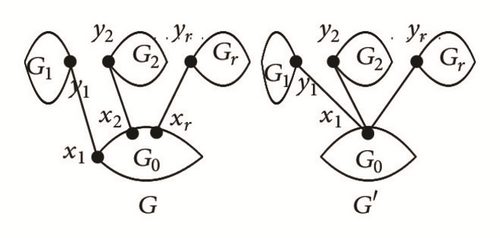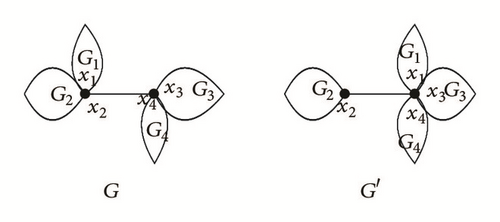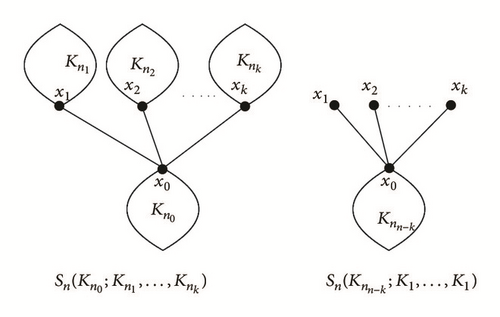On the Resistance-Harary Index of Graphs Given Cut Edges
Abstract
Graphs are often used to describe the structure of compounds and drugs. Each vertex in the graph represents the molecule and each edge represents the bond between the atoms. The resistance distance between any two vertices is equal to the resistance between the two points of an electrical network. The Resistance-Harary index is defined as the sum of reciprocals of resistance distances between all pairs of vertices. In this paper, the extremal graphs with maximum Resistance-Harary index are determined in connected graphs with given vertices and cut edges.
1. Introduction
Recently, the development of computational chemistry owes much to the theory of graphs. One of the most popular areas is topological index. The molecular topological index can describe the molecular structure quantitatively and analyze the structure and performance of molecules.
Among them, the most common topological index is resistance distance. The resistance distance is raised by Klein and Randić [1] as a distance function. Let G be a simple connected graph with vertex set V(G) and edge set E(G).
The resistance distance between vertices u and v of G is recorded as rG(u, v), which represents the effective resistance between two nodes u and v in an electronic network; that is to say, the vertex corresponds to the node of the electronic network, and the edge corresponds to the unit resistance.
Similar to the traditional path distance, the resistance distance not only has good mathematical characteristics but also has good physical characteristics [2, 3]; at the same time, it also has a good application in chemistry.
Gutman [6] and Xu [7] investigated the Harary index of trees; they studied the Harary index of tree and pointed out that the path and the star attain the minimal and maximal value of Harary index, respectively, among a tree with given n vertices. In recent years, the Harary index was well studied in mathematical and chemical literatures [8].
In [10], using graph theory, electronic networks, and real number analysis methods, Yang obtains some conclusions about the global cyclicity index.
In [11], Chen et al. depicted the graphs with largest and smallest Resistance-Harary index in all unicyclic graphs.
All graphs considered in this paper are finite and simple.
Before proceeding, we introduce some further notation and terminology. A cut edge is an edge whose deletion increases the number of components. Denote by Kn, Cn, and Sn the complete, cycle, and star graph on n vertices, respectively. For a graph G with v ∈ V(G), G − v denotes the graph resulting from G by deleting v and its incident edges. For an edge uv of the graph G (the complement of G, resp.), G − uv (G + uv, resp.) denotes the graph resulting from G by deleting (adding, resp.) uv.
For other definitions, we can refer to [12].
In this thesis, we consider the Resistance-Harary index of graphs given cut edge. We will determine the graphs with maximum Resistance-Harary index in connected graphs given vertices and cut edges.
2. Some Preliminary Results
We first list or prove some lemmas as basic but necessary preliminaries.
Lemma 1 (see [1], [13], [14].)Let x be a cut vertex of a graph G, and let a and b be vertices in different components of G − x. Then
Lemma 2. The functions f1(x) = x/(2/x + m) − (x − 1)/(2/(x − 1) + m) for x ≥ 2 and m > 0 and f2(x) = x/(2/x + A)(2/x + B) for x > 1 and A > 0, B > 0 are strictly increasing.
Proof. By simple calculation,
Since x ≥ 2 and m > 0, is the derivative of function f1(x) on x. Obviously, f1(x) is a strictly increasing function for x ≥ 2 and m > 0.
Similarly, we prove that the function f2(x) = x/(2/x + A)(2/x + B) for x > 1 and A > 0, B > 0 is also an increasing function. We finally obtain the result.
Lemma 3. Let G be a connected graph with at least three vertices. If G is not isomorphic to Kn, Let G∗ = G + e, and then RH(G∗) > RH(G).
Proof. Suppose that G is not a complete graph. Then there exists a pair of vertices vi and vj in G such that .
Let G∗ = G + vivj, we have
Case 1. vi and vj are vertices of cycle Cg in G, where g is the length of Cg.
Let d1(vi, vj) and d2(vi, vj) be distance between vi and vj in the cycle Cg, respectively. By the definition of resistance, we have
Case 2. vi and vj are not vertices in any cycle of G.
In this case, we have
Lemma 4. Let xy ∈ E(G) be a cut edge in G, and let G1 and G2 be the two components of G − xy. Suppose further that x ∈ V(G1) and y ∈ V(G2), and then .
Proof. By the definition of Resistance-Harary index and by Lemma 1, we have
This completes the proof.
Lemma 5. Let G and G′ be the graphs in Figure 1, where G0 is a complete graph, and then RH(G) ≤ RH(G′), with equality if and only if x1 = x2 = ⋯ = xr.

Proof. From the definition of the Resistance-Harary index and Lemma 4, we have
Lemma 6. Let G and G′ be the graphs depicted in Figure 2, where G2 and G3 are all complete graphs. Let ni be the number of vertices of Gi, where i = 2,3. If n3 > n2 and V(G4) may be an empty set, then RH(G′) > RH(G).

Proof. By the definition of the Resistance-Harary index and Lemmas 1 and 4, we have
In fact,
In the following, we just need to prove that the fraction of ∇1 is greater than zero. Denote ∇2 to be the fraction of ∇1; in fact,
3. Characterization of the Maximizing Graph
In this section, we will characterize maximizing graph among all connected graphs with n vertices and k cut edges.
First, we need some definitions below; let sk+1 be a star with vertex set {v0, v1, …, vk}, where v0 is the center of the star. In particular, the graph with is obtained from Sk+1 by replacing the vertex vi by for i = 0,1, 2, …, k. By the definition of Resistance-Harary index, it is not difficult to obtain RH(Kn) = n2(n − 1)/4. If G0 is a complete graph, for any vertices x0, a ∈ V(G0), there is .
Lemma 7. Let n and n0, n1, …, nk (k ≥ 1) be positive integers such that n0 ≥ n1 ≥ ⋯≥nk, n1 > 1, and n0 + n1 + ⋯+nk = n. Let (see Figure 3) and . Then RH(G′) > RH(G).

Proof. By direct calculation, we have
Obviously, △2 > 0. In the following, we first prove that △1 > 0. By direct calculation, we have
By combination with above discussion, we have RH(G′) > RH(G), which finishes the proof of Lemma 7.
Corollary 8. Suppose that is defined as above and n0 ≥ n1 ≥ n2 ≥ ⋯≥nk, the value of reaches its maximum value at n0 = n − k and n1 = n2 = ⋯ = nk = 1.
Theorem 9. If G is a connected graph with k cut edges and n vertices, then
Proof. To determine the maximum Resistance-Harary index of the graph, we select such a connected graph so that it cut off all the cut edges for a complete graph by Lemma 3. Moreover, we can further choose by Lemmas 5 and 6, and let , n0 = max{n0, n1, …, nk}. From the definition of the Resistance-Harary index and Lemma 4, we have
Corollary 10. If T is a tree with n vertices, then RH(G) ≤ (n2 + n − 2)/4, with equality if and only if T≅Sn.
Proof. Since T is a tree with n vertices, it has n − 1 cut edges, and RH(G) ≤ (n2 + n − 2)/4 with equality if and only if T≅Sn by Theorem 9. This completes the result.
4. Conclusion
In this thesis, we considered the Resistance-Harary index of graphs with given number of cut edges and describe a graph with a maximum Resistance-Harary index. A problem raised naturally at this moment is, among all connected graphs with n vertices and k cut edges, which graph has the minimum Resistance-Harary index? We will continue to consider this problem in the nearest future.
Conflicts of Interest
The authors declare no competing financial interests.
Acknowledgments
Wang was supported by National Natural Science Foundation of China under Grant no. 11571135 and Humanities and Social Sciences of Ministry of Education Planning Fund under Grant no. 16YJA630032. Hua was supported in part by National Natural Science Foundation of China under Grant no. 11571135.




